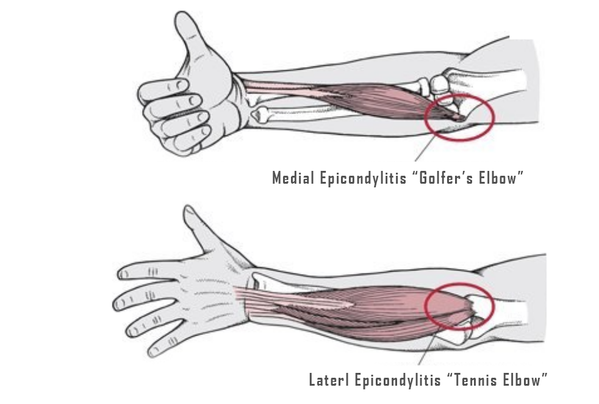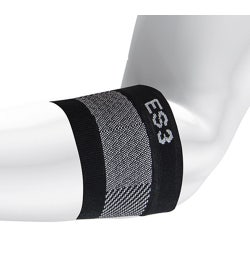Tennis Elbow and Golfer's Elbow Basics
Repetitive strains are a common result of many recreational activities, two of the most popular being Tennis Elbow and Golfer’s Elbow. We see an increase in overuse injuries when the weather starts to get warmer, and people begin to return to summer-time activities, but they can really happen any time of year! The two conditions are similar, and many people confuse these two painful disorders.
Golfer’s Elbow, also known as Medial Epicondylitis, affects the forearm muscles that attach from the wrist to the “funny bone” area of the elbow, near the inner part of the elbow. This is where you may feel pain or tenderness. The discomfort and irritation is caused by activities that involve repetitive wrist flexion (bending your hand down) and twisting the palm downwards. The pain from golfer's elbow is due to tendonitis or inflammation on the tendon on this inside part of the elbow. The pain can be nagging and become severe.
Golfer’s elbow is not limited to those who play golf. It can be found amongst players of many activities, such as: racquet sports, throwing sports, weight training, and even those in occupations of heavy labour.

Tennis Elbow, also known as Lateral Epicondylitis, affects the muscles and tendons of your forearm, which extend to your wrist and fingers. You may feel pain and tenderness on the outer part of your elbow. The cause is repeated contraction of the forearm muscles that you use to straighten and raise your hand and wrist. Similar to Golfer’s elbow, it may develop gradually, with mild pain, which can get worse over time. It is not exclusive to tennis either but can be a result of repetitive activities such as: certain racquet sports, manual labour, using tools in turning motions, and even knitters/crocheters.
Essentially, both conditions can be caused by several activities, whether you play golf, tennis, or not. You can also be affected by both conditions! When activities involve heavy use of both the lateral and medial sides of the forearm. This why you see some braces and supports that are designed to treat both conditions.
Treatment
One of the best treatments for either condition is to modify the activities causing pain. This may mean reducing the repetition or duration of the activities causing the issue. Physiotherapists most commonly recommend taking a break and icing the affected area, as well as using anti-inflammatory medication. Medical professionals also commonly prescribe a compression or stability brace which are very effective in providing immediate pain relief and giving the effected area some time to heal.
Braces & Sleeves for Tennis Elbow and Golfer's Elbow
The elbow braces and sleeves pictured below provide relief from pain associated with Tennis and Golfer's elbow. Some of the braces are designed to treat both conditions.
With the elbow braces, a soft pad applies specific pressure near the tendon insertion point, at the elbow joint. They are lightweight and can easily be worn during activity. These types of elbow braces, often referred to as 'counter-force braces', come in strap or band versions (some with compression) that helps relieve and take the strain off of the tendon.
Consider this example for how the braces work: Imagine you are trying to brush out a knot in your hair (for those of us with hair past our ears). Trying to brush this knot out may be painful, as it catches the brush, and pulls on our scalp. By holding the hair just before the knot, and limiting the pulling on the scalp, we can brush the knot out without causing significant pain. This is how these braces work: allowing the tendon to heal while limiting the pulling action on that inflamed area.
Another option for helping to heal damaged tendons comes in the form of an elbow compression sleeve. These are great at stabilizing the joint, by providing cushioning at the elbow, and incorporating compression to reduce swelling in the area.
Popular Braces for Golfer's Elbow
Many people ask if they can continue golfing with golfer's elbow. If you are playing golf with golfer's elbow, it is important to wear a brace or support. The support can be worn even when you are not actively playing golf to provide pain relief and support healing.
Popular Braces for Tennis Elbow
Similar to Golfer's Elbow braces, you can use the Tennis Elbow support brace during physical activity as well as throughout the day.
If you’re affected by any of these conditions, don’t forget to consult your physiotherapist or healthcare practitioner for more information on how to alleviate the pain and swelling. Together, a brace and the right exercises may be your best bet to overcoming Tennis or Golfer’s Elbow.
If you have any questions about what the best elbow brace is for your condition contact our Healthcare Team for fast advice before you buy.
















































